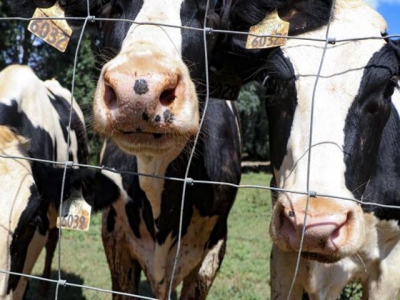Heat stress alters mammary gland, dairy calf performance

Lack of cooling during summer may reduce milk yield of lactating cows by 20 lb. per day.
When cows are exposed to a temperature-humidity index above 68, their milk production begins to decrease. University of Georgai animal and dairy scientists are searching for ways to ease heat stress and improve dairy productivity. Photo by University of Georgia
Summer heat can make it hard to do almost anything outside and, for dairy cows, that includes producing milk. Heat stress is inevitable in the Southeast U.S., and the first week of August saw temperatures soar past 100°F, according to the University of Georgia.
Heat stress can negatively affect dairy cows and their milk production, but researchers at the University of Georgia Tifton campus are working to keep cows happier, healthier and producing milk, an announcement said. When cows are exposed to a temperature-humidity index above 68, their milk production level begins to decrease, according to dairy scientist Sha Tao, whose research focuses on how to help dairy farmers manage heat stress.
Since joining the department of animal and dairy science at the University of Georgia College of Agricultural & Environmental Sciences in 2014, Tao has been studying how nutrition, cattle management and physiology can affect milk production, dairy cow fertility and overall health.
“Heat stress is a major issue in the dairy industry. Caused by high temperatures and high humidity, it will lead to several physiological adjustments of the cows. You’ll have increased body temperature [and] increased respiration rate,” Tao said. “If we can understand how heat stress influences a cow and calf metabolically and physiologically, we can develop some additional management strategies or nutritional/pharmaceutical interventions to reduce the impact. We can’t 100% mitigate the impact of heat stress, but we can develop information that will better aid dairy [farmers].”
Tao’s two primary goals with his research are learning how heat stress affects mammary gland functions and how nutritional management affects calf performance during the summer, the university said.
“In our dairies here in the Southeast -- for example, Florida and Georgia -- we face the most severe heat stress issues, and that’s because we have longer summers and more humidity. That causes problems,” Tao said.
“Our study indicates that deprivation of cooling during Georgia summers reduces lactating cows’ milk yield by 20 lb. per day. Part of the reason for this lower milk production is the altered mammary gland development. Our finding suggests that deprivation of cooling induces the death of mammary epithelial cells, which are the cells that produce milk in the mammary gland,” Tao said.
He added that newborn calves have slower growth during the summer and said a potential solution offered was to increase the amount of milk replacer fed to provide more energy and nutrients for better growth.
However, Georgia research suggests that feeding calves a milk replacer containing 26% protein and 17% fat at 2 lb. of solids in two feedings per day causes more metabolic diseases, such as abomasal bloating, and fails to improve growth.
“Feeding large amounts of milk replacer during the summer, when fed twice per day, may not be a valid option to improve calf performance,” Tao said.
Dairy producers already employ heat management strategies to help dairy cattle stay cool during the summer. Fans, misters and soakers are used to cool cattle at dairy operations across the Southeast, including the research farm Tao uses for his studies at Tifton.
Results of his research have the potential to yield real-world benefits for dairy farmers, as reduced milk production caused by heat stress leads to a $2 billion annual loss in the U.S., Tao said.
Source: University of Georgia, which is solely responsible for the information provided and is wholly owned by the source. Informa Business Media and all its subsidiaries are not responsible for any of the content contained in this information asset.
Có thể bạn quan tâm
 Seaweed slashes methane production in first live study with cows
Seaweed slashes methane production in first live study with cows Scientists now have in vivo evidence that Asparagopsis seaweed can reduce methane emissions from dairy cows, providing further support for the use of this
 Canada: Cattle feed tools shed light on ingredient nutrition, value
Canada: Cattle feed tools shed light on ingredient nutrition, value A set of new, online tools is aimed at making information about nutritional components in cattle feed and the economic value of feed or feed ingredients more
 Yep dairy cows really love water beds
Yep dairy cows really love water beds When dairy cow water beds first appeared in the late 1990s, it was understood that it’s important for a cow to lie down, but mostly, cow beds were simply